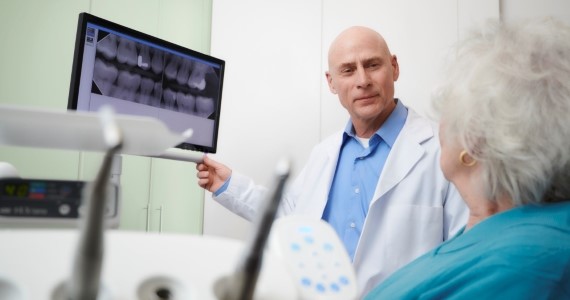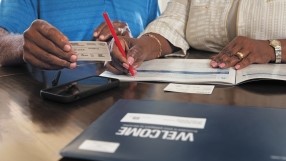Emergency Tooth Extractions: What To Expect
Be prepared if you need an emergency tooth extraction.

Why Might I Need an Extraction?
Most people would like to keep their natural teeth for a lifetime. However, there are situations where a natural tooth cannot be saved. Aside from wisdom tooth removal, a person may require tooth extraction(s) due to infection, severe decay, broken teeth or excessive tooth crowding in preparation for orthodontic care. You can reduce your risk of a potential extraction(s) by practicing good home care and visiting your dentist for routine checkups. If you are experience pain, contact your dentist as soon as possible for an exam. Your dentist will diagnose the problem and provide treatment options.
Infection
The pain from an infected (abscessed) toothcan be very acute, leaving you unable to focus or even sleep. Swelling of the face may accompany the pain, making the situation unbearable.
Tooth abscesses can develop due to a crack, chip, break, or deep cavity in a tooth. This allows bacteria to reach the pulp and root of the tooth. A pus pocket may develop below the tooth root or on the side of the gum, putting pressure on the nerves.
Your dentist can drain an abscess and treat the infection with antibiotics. However, the infection is likely to return unless your dentist treats the tooth further. The two treatment options for this kind of infection are a root canal or extraction. Root canal treatment can help preserve the tooth. After a root canal, a tooth typically needs a crown. As a result, saving the tooth can be costly. Instead, you may choose to have the tooth removed. There are instances when an abscessed tooth is damaged beyond repair, so your dentist may recommend an emergency extraction.
Before extracting an infected tooth, your dentist may first send you home with a prescription for an antibiotic and pain management instructions. Though the last thing you might want to do is delay treatment, if the infection is severe enough, this step may be critical. This is because active severe infections can reduce the effectiveness of the local anesthetic your dentist would use to numb your mouth for the extraction.
Severe Tooth Decay and Broken Teeth
A tooth that is broken off, cracked in half, or severely decayed may also require an emergency extraction.
What Happens During an Extraction Appointment?
-
Prior to performing an extraction, your dentist will review your medical history and medications to determine if there are any risks in performing the procedure.
- If you take blood thinners, for example, you may have to stop taking them for several days to reduce the risk of excessive bleeding.
- You will have X-rays taken so your dentist can see the position of the tooth and its condition below the gums. Your dentist will use this diagnostic image to determine if they feel comfortable performing the extraction or if a referral to an oral surgeon may be necessary.
-
If you agree to the extraction, your dentist will use a local anesthetic, to numb the area.
- Your dentist may use a sedative like nitrous oxide (laughing gas) if you are anxious about dental treatment.
- An oral surgeon may also recommend IV sedation or general anesthesia, though this level of sedation is not always necessary.
-
After you are sufficiently numb and/or sedated, your dentist:
- Loosen the tooth with a dental instrument for a simple extraction.
- Make a small incision next to the tooth if a surgical extraction is necessary.
- Split the tooth or remove some bone it does not loosen easily.
-
Next, your dentist will remove the tooth.
- If your dentist made a surgical incision, they may place stitches to help the gum tissue heal properly.
- Lastly the dentist will place gauze over the extraction site.
What Should I Do After an Extraction?
After an extraction, you should follow the after-care instructions provided by your dentist as closely as possible. These instructions typically explain:
- How long to keep the gauze on the extraction site
- When bleeding should stop
- How to keep the area clean
If the area continues to bleed for longer than your dentist's estimation, you should notify your dentist/surgeon right away.
After an extraction, a normal part of the healing process includes a blood clot developing at the extraction site. It is important that this clot remain in the extraction site. It serves as protection from bacteria and food particles getting into the empty tooth socket. This helps to prevent a secondary infection and dry socket. More importantly, the clot acts as the foundation to help your body form new bone.
To prevent this blood clot from being dislodged, avoid sucking on candy, using drinking straws or smoking cigarettes for 24 hours. The sucking action can dislodge the clot from the tooth socket.
After an extraction you should also avoid vigorously rinsing your mouth, brushing your teeth next to the extraction site, and high intensity exercise for the period suggested by your dentist. All of these activities increase the risk of losing the blood clot. Contact your dentist or surgeon immediately if you experience any complications after an extraction.
Can My Dentist Perform an Extraction?
Many general dentists perform both simple and more complex extractions. However, there are cases when your dentist may refer you to an oral surgeon. These cases may include but are not limited to:
- A tooth broken off to the root.
- An extraction that appears too complex.
- The presence of complicated dental anatomy in the area of the tooth to be extracted.
- Tooth structure so weak that there is a high risk for the tooth to break off while attempting the extraction.
Note: The information in this document is not meant to replace the advice of your dentist or another licensed healthcare professional. Talk to your dentist for any specific dental advice.






